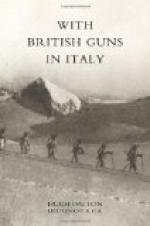Coming back we stopped at the foot of a hill on which stands the shell-wrecked monastery of San Grado di Merna, a white ruin gaunt against the darker background of the Nad Logem. Here a new Battery position was being prepared for us, only three hundred yards behind the Austrian front line, but admirably protected by the configuration of the ground from enemy fire. An Italian drilling machine was at work here, operated by compressed air, drilling holes in the rock for the insertion of dynamite charges, and, by means of gradual blasting, gun pits and cartridge recesses and dug-outs were being created in the stubborn rock. Here a heavy thunderstorm broke and we sheltered in the Headquarters of an Italian Field Artillery Brigade, likewise blasted out of the mountain side. I returned with Venosta. I asked him to show me the famous Bersagliere trot, and by way of illustration we doubled along the road for about half a mile. On the British Front the spectacle of two officers thus disporting themselves for no apparent reason would have caused much remark and amusement. But the Italians, whom we passed, seemed to see nothing remarkable in our behaviour. They are, perhaps, more tolerant of eccentricity than we are.
It may be of interest at this point to say a few words about some of the special characteristics of the Italian Army. Every modern Army has adopted a distinctive colour for its war-time uniform, chosen with a view to minimising visibility. Thus we wear khaki, the French horizon-blue, the Germans field-grey. The Italians have adopted an olive colour, commonly spoken of as “grigio-verde,” or grey-green.
The various Italian Corps, Regiments and Brigades wear distinctively coloured collars on their tunics which, except in the case of the Arditi, fit closely round the neck. For example, the Granatieri, or Grenadiers, who both in their high physical standards and military prestige resemble our own Guards Battalions, wear a collar of crimson and white. The colour of the Artillery is black with a yellow border, that of the Engineers black with a red border. Of the Infantry, the Alpini collars are green and the Bersaglieri crimson, the bands of colour being shaped in each case like sharp-pointed flames turning outwards. For this reason the Alpini are often called the “fiamme verdi,” or green flames, and the Bersaglieri “fiamme rosse,” or red flames. The Infantry Brigades of the line, who bear local names,—the Avellino Brigade, the Como Brigade, the Lecce Brigade and so forth,—have each their distinctively coloured collars.




